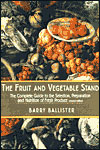Review © 2002 by Burton Kaplan
Barry Ballister’s Fruit and Vegetable Stand:
A Complete Guide to the Selection, Preparation and Nutrition of Fresh Produce
Barry Ballister
The Overlook Press, Woodstock & New York
Revised edition 2002, 455 pp, ppk, $19.95, CDN$31.60
ISBN 1-58567-147-9

Talk about professional!
Before he examined the car, Malmo, the Swedish car guy I was referred to, donned a clean white jumpsuit, fresh rubber gloves, and a surgical mask. Putting his hands under the transmission, he asked the engine to cough.
To tell you the truth, some of the dinosaurs in the Museum of Natural History are only five years older than my Saab 900. But it was getting so I couldn't afford to run it anymore. Especially not at the prices my former mechanic used to charge. The last bill I got from her was $650 for an engine adjustment. At those rates she must've called in James Levine to do the tune-up.
Done at last with his clinical work-up, Malmo returned to the waiting room to deliver the bad news.
"Let me put it this way, " he said. "If your car was a horse and I was a veterinarian, I'd be obliged to shoot it."
He laid out a plan for a mechanical restoration that would take, step-by-step, about a year and roughly $5,000 to 6,000, provided we didn't run into what he called, "complications."
I demurred.
He didn't.
"Five grand to me or $35,000 to the car dealer. It'll last you another 200,000 miles and, besides, you've got the radio broke in just the way you like it. That's somethin' to think about right there, you betcha."
As I pondered his surgical prescription for my machine I naturally tried to avoid considering it at all. I began thinking instead about other peoples' cars.
Well, you know how it is, one thing having a way of leading to another. Before I knew it, Shazam! I had solved the mystery of terrible tomatoes. That's right. After years of fruitless thinking I suddenly KNEW exactly who is to blame for bad winter tomatoes on the eastern seaboard, and it wasn't some nameless and faceless "them." No, it was a definite somebody.
Who?
None other than Henry Ford!
That's right. Ford. If he didn't popularize cars, roads would never have been built – the ones Florida tomato haulers use. Q.E.D.
It was just about then that a new and revised edition of Barry Ballister's 1987 book appeared on my desk. A quick thumbing of this greengrocer's man-bites-dog approach to farm output revealed that he, too, lays blame for tomatoes that are " ... hard and thick, never turn red, and always disappoint our taste" on the demands of shipping. What a smart writer! I was immediately disposed to like his book.
Reading it completely, however, "complications" obtain. But before we get to these let it be said that here is a book that describes 175 varieties of everything from apples to zucchini, including 20 kinds of lettuce; how to find summer fruit the year-round; ripening fruit at home, charts for each entry offering information on calories, protein and carbo content, vitamins and minerals. While there is nothing here that an alert reader could not easily compile with a visit to the United States Department of Agriculture website, there is something to be said for the all-in-one-volume convenience Ballister provides.
Most people buy food-related books as much to read as to cook or shop from. On this dimension, Ballister's work is less than the pick of the crop. Contrary to blurb copy's promise of "fascinating" writing, the author's personal anecdotes amount to an oft-heard tale–the ad man who burns out early on Madison Avenue and returns to his family's roots as a fruit peddler. In the process, he anoints himself a latter-day noble savage. A smidgen of this stuff here and there might have made for interesting relief from prosaicisms the likes of, "Red bananas are like yellow bananas, only different." But 30 dense, single-spaced pages of polishing one's own apple qualifies Ballister for this publishing season's My Cup Runneth Over award. As for the book's "more than 300 fruit, vegetable, and juice recipes for every occasion from main course to dessert," here's one in its entirety: "Cut watermelon into 2-inch-thick chunks. Sprinkle with lime juice. Sprinkle lightly with salt."
Weighing in at 455 pages, the heft of the text seems ill-suited to glued-up paper covers likely to self-destruct long before the book pays back its keep. Equally unattractive are pages printed on pulpy paper certain to absorb the stains and splatters of the scullery.
While there are any number of things to be said for this title – for instance, it may be adequate for kinderkitcheners – value is not one of them. Before purchasing, advanced home cooks on the lookout for professional guidance in the choice, selection, and preparation of fruit and vegetables will want to consider Daniel Boulud's first cookery and the last of the River Café series. These offer less palaver, a more sophisticated take on food, exciting produce-based recipes, and, best of all, paradigmatic photo illustrations in full color.
It's an amazing thing, really: I mention value and the Malmo experience whooshes back to mind. It leaves me wondering yet again why, in its infinite wisdom, the worldwide automobile industry can make machines that come in every price range but one: affordable.
And oh, yes, my decision to restore the Saab. It wasn't Malmo who prevailed. It was the state of my bank account. But to give credit where it is due, Malmo was on point: I'd hate to have to teach another radio how to boogie.
April 2002




